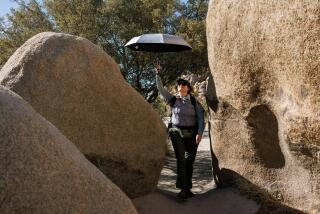Conscience letters of the Petrified Forest
They’re known as conscience letters — notes sent to the rangers at the Petrified Forest National Park in Arizona, by visitors returning pilfered rocks. “I am writing this letter in hopes of easing my conscience,” one missive reads, “and saving the most important thing in my life, my marriage.”
This, along with dozens of other odd pieces of correspondence, appears in “Bad Luck, Hot Rocks: Conscience Letters and Photographs from the Petrified Forest” (144 pp. $32.50 paper), edited by Ryan Thompson and Phil Orr. Published by the Ice Plant, the Los Angeles-based art and photography press, this is my favorite sort of book: a collection of detritus, overlooked and long forgotten, that adds up to an unexpected narrative.
In that sense, I suppose, it’s not unlike the Petrified Forest itself.
Thompson first discovered the conscience letters on a visit to the forest in 2011. “I was immediately drawn to them,” he writes in a brief introduction, “for their humor, heartbreak, and humility.” Part of the attraction was the legend of a curse: “stories of misfortune, attributed directly to [the] stolen petrified food.” Such accounts appear throughout “Bad Luck, Hot Rocks.”
“Upon returning home,” one letter reads, “we first found out that my step mother had kidney failure, then our dog died, our central air conditioning went out and our freezer .… So Please take these pieces back before we have any more bad luck.”
Another declares, simply: “Here are your rocks, nothing but bad trouble.”
To some extent, Thompson suggests, the curse has become self-perpetuating at this point, since the Rainbow Forest Museum, which is part of the national park, features a selection of them on display. As such, they represent a bit of collective folklore, a myth built from the bottom up.
Still, reading through these letters, reproduced here in full-color facsimiles, it’s hard to get away from the sense that the writers are looking for a connection to something larger than themselves. This is why they took the rocks in the first place, and also (perhaps) why they attribute fortune to the choice.
We are adrift, after all, in a world that is a mystery to us, in which geology offers glimpses of a past we cannot recognize. If wood can turn to stone, over the course of millions of years, what does that mean for us? How do we find meaning in the face of that blank history — not to mention the serendipity of our own lives?
“I’m not superstitious,” writes a woman who took a rock as a souvenir while on her honeymoon, “but, a year later, my husband was killed in an airplane crash not far from your facility. Since then, my life has been in turmoil. I just want to get rid of this reminder. Please put it back where it belongs.”
The irony is that these rocks can’t go back where they belong; that would “spoil those sites for research purposes.” Instead, Thompson informs us, they are “added to the park’s ‘conscience pile,’ which sits along side a private gravel service road.”
The implication is that there is no way to make up for, to rewrite, our actions once they are committed. And yet, our stories matter all the same.
Indeed, if “Bad Luck, Hot Rocks” has any anything to tell us, it is that in sharing these small, seemingly insignificant confidences, we find comfort, consolation, if not quite redemption that they are, as they have always been, the currency of our living, for good or ill.
Twitter: @davidulin
More to Read
Sign up for our Book Club newsletter
Get the latest news, events and more from the Los Angeles Times Book Club, and help us get L.A. reading and talking.
You may occasionally receive promotional content from the Los Angeles Times.











